Whipps Cross University Hospital
Whipps Cross Road, Leytonstone, E11 1NR
Medical dates:
Medical character:
Mainly acute
In 1889 the West Ham Guardians
bought Forest House and its estate of 44 acres of grounds as a site for
a future infirmary, for which planning approval was granted in 1894. The old mansion house was then used from that year as
an annexe to the West Ham Union workhouse in Leyton to accommodate elderly infirm men.
Building work on the new infirmary began in 1900 and was completed three years later, having cost over £186,000.
The West Ham Union Infirmary opened in 1903. It comprised a central administration building with ward blocks on either side.
The administration building was flanked by two massive towers. Receiving wards, each with its own bathroom, were located on either side of a large entrance hall - the one on the right for men and the one on the left for women. Corridors connected the wards to the residences of the Medical Superintendent and the Assistant Medical Officers.
The Medical Superintendent lived in a commodious detached house to the right behind the administration block. The medical staff quarters, to the left, contained bed and sitting rooms for three doctors and a common dining room. The other part of this house contained a suite of rooms for the Matron and two Assistant Matrons.
The kitchen lay immediately behind the main corridor of the main administration block, off of which, right and left, were the Medical Superintendent's office, Matron's rooms, nurses' and probationers' rooms, dining rooms, workrooms and storerooms. Behind the kitchen were the sculleries and the servants' hall.
On the first floor, at the front of the administration block, was a chapel which could accommodate 200 people and, at the rear, bedrooms and bathrooms for the domestic staff.
The four symmetrical ward pavilions - two on either side of the administration building (the ones on the right for men and those on the left for women) - contained 672 beds. Ward Block A consisted of six wards of 24 beds each and 12 isolation wards of two beds each. Ward Blocks B, C and D were identical; each contained 168 beds. Access to the wards was through an entrance lobby from the small central administration ward block, which contained a stairway, lifts and utilities. Each Ward Block had two lifts - one for patients and the other for food delivery (three other lifts in the Infirmary were service lifts). At the entrance to each large ward were two isolation wards, a nurses' duty room, a Day Room for the patients and a linen store.
The tower annexes to the Ward Blocks contained bathrooms and WCs.
The 3-storey buildings were linked by tiered covered walkways at each level.
The Infirmary was lit by electricity and had central heating, which was auxiliary to the open fireplaces. Each large ward had a double-fire descending flue stove. The basement areas of the Ward Blocks were mainly used to store coal, although on the west side were the Steward's office and the storerooms for meat and milk. A subway under the main corridors contained electricity cables, hydrants and the pipes for steam and hot and cold water. The boiler house was connected to the administration block by a tunnel.
Between Ward Block B and the central administration building was a Board Room. Immediately underneath this was a room of similar size, intended to be used for religious services. Next to the Board Room, and between it and the administration building, was a detached ward for short-term lunatics. It contained 2 beds, a bathroom, a WC and an attendant's room (off which was a padded cell).
The dispensary and drug store were located in a detached building on the other side of the administration building, between it and Ward Block D. It was connected to the main corridor at ground level.
To the rear of the administration building were the laundry and boiler house. The self-contained laundry had washing, drying and ironing rooms. There was a clothing disinfecting chamber, as well as a storeroom for inmate's clothing, and accommodation for the Head Laundress. Adjacent to the boiler house was the machine room containing engines and dynamos, etc., with storage for batteries. Workshops for the carpenter and the smith lay at the end of this building. Houses for the engineer and the Steward were located to the east of these.
Initially the nursing staff consisted of 23 trained and 63 probationer nurses. The Nurses' Home contained separate rooms for 72 nurses, and bed and sitting rooms for the Home's Superintendent. On the ground floor were two recreation rooms, one each for the nurses and the probationers. These could be made into one large room, when required, for parties and entertainments.
An ambulance station and its stables were by the entrance from Whipps Cross Road, as was the mortuary building, containing a dead house, a waiting room and a small chapel, and a post-mortem room.
The Infirmary's water supply came from an artesian well sunk to a depth of 400 feet (122 metres). If needed, this could be supplemented by water delivered direct to steel storage tanks in the water towers from the East London Waterworks Company.
Although originally there had been no operating theatre, this was soon added, although it was known as the 'operating room' as the word 'theatre' was considered to be too alarming to the patients. By 1912 some 350 operations a year were being performed.
During WW1, in 1917 part of the Infirmary became the Whipps Cross War Hospital. It was affiliated to the Colchester Military Hospital and 240 beds were given over for wounded and sick servicemen. King George V and Queen Mary visited in November 1917, commenting on the magnificence of the buildings. The Queen presented medals and certificates to the nurses who has passed their Final examinations that years.
By the end of the war in 1918 the Infirmary had become a general hospital. Its name was changed to Whipps Cross Hospital.
During the 1920s the first specialist consultants were appointed to the medical staff. They established departments in dermatology, ophthalmology, genitourinary surgery and ear, nose and throat conditions.
In 1926 the Board of Guardians who managed the Hospital were dismissed by Neville Chamberlain, the Minister of Health, as they had run up a debt of £250,000.
In 1930 the Boards of Guardians were abolished and control of the Hospital was taken over by West Ham Borough Council. The Council added new ward blocks and, by 1936, the Hospital had 741 beds and had been recognised as a training school for nurses. During the years 1938-1940 four new blocks were built at the eastern end of the original buildings.
During WW2 the Hospital joined the Emergency Medical Service, with 388 of its 744 beds reserved for civilian air-raid casualties.
In 1948 the Hospital joined the NHS under the control of the Leytonstone Group Hospital Management Committee, part of the North East Metropolitan Regional Hospital Board. It had 1,044 beds, of which 846 were open.
During 1948 and 1949, following alteration, Wards C.5 and C.6 became TB wards for male and female patients, while Edward and Margaret Wards were converted into accommodation for babies and children.
In 1950 Ward B.5 was converted into improved facilities for the Pathology Laboratory. In the following year Ward A.2 became an X-ray Department with four major units, and Ward A.7 a Physiotherapy Department. Ward A.6 was adapted as permanent accommodation for the Pathology Department, with the provision of an animal house. The side rooms of Ward A.5 provided added facilities for the Pathology Laboratory. The verandah was enclosed in the Occupational Department.
In July 1951 an extension to the X-ray and Physiotherapy Departments was opened by the Revd Reginald Sorensen, M.P. (in place of Arthur Blenkinsop, M.P., the Parliamentary Secretary to the Minister of Health, who had been delayed by unavoidable Parliamentary business).
In 1951 the Wilfred Lawson Temperance Hotel in Woodford Green was purchased by the Regional Hospital Board as additional accommodation for 50 nurses. The Hospital Management Committee decided to use the premises also as a Preliminary Training School for student nurses; this opened on a temporary basis in October 1951. The nurses' badges bore the Hospital's motto: Semper ad coelum (always aim high).
In November 1955, when the Hospital had 974 general medical and surgical beds, Nightingale Ward was opened as an additional surgical ward. A new Medical Records Department was set up in C.2 Ward. Wards D.5 and D.6 were converted into a new Physiotherapy Department at a cost of £320.
A new entrance to the Hospital was built, at a cost of £2,030, and the old waiting room made into a Porter's Lodge. A new deep well water pump, which could pump 6,000 gallons an hour, was installed for £680. The main operating theatre was redecorated, a new floor laid and new sterilizing equipment installed for £320. Some £1,680 was spent on various lights and £830 on re-roofing the new ward blocks with asphalt. The X-ray darkroom was divided into two darkrooms at a cost of £500. An office for the Pharmacy was created for £110.
The Wilfred Lawson Preliminary Training School was fenced off for £156 to provide privacy for the resident nursing staff. The hall and classroom were redecorated for £475.
A replacement concrete greenhouse was built for £675 so that the supply of flowers and floral decorations would be constant during the winter months.
In 1956 the weekly cost of an in-patients was £20 16s 10d (£20.84), compared with £19 4s 0d (£19.20) the previous year - an increase of 8.5%.
Essex County Council purchased three-quarters of an acre of land adjacent to James Lane in order to build a modern Ambulance Station.
C.5 Ward was adapted for £2,450 for the treatment of patients with rheumatism and non-tuberculous chest conditions.
An Out-Patients Department opened, somewhat belatedly, in 1958.
In October 1959 the Sub-Regional Ophthalmic Unit opened. It contained a male and female ward of 12 beds each and a 6-bedded ward for children, and a compact ophthalmic operating theatre.
By the end of the 1950s, because of the ever-increasing number of visitors' cars, the Hospital Management Committee decided to cease offering parking facilities for visitors within the Hospital grounds. During visiting time the roadways would be choked with vehicles and emergency ambulances were unable to get through.
In 1962 the original mansion, Forest House, which had been used as a ward for male mental patients, closed when the newly built Samuel Boyce Lodge opened in its gardens. (The mansion was demolished two years later. Its site later became a carpark.)
In 1963, when the Hospital had 978 beds, it transferred to the control of the Forest Group Hospital Management Committee.
In 1965 a Medical Education Centre opened. It was one of the first in England. An Intensive Care Unit opened in 1968, as did a Hyperbaric Unit.
In 1969 the Whipps Cross Hospital Radio was founded by the Walthamstow Lions Club to provide entertainment for the patients and staff.
A Maternity Wing opened in 1973.
In 1974, following a major reorganisation of the NHS, the Hospital came under the control of the West Roding District Health Authority, part of the Redbridge and Waltham Forest Area Health Authority of the North East Thames Regional Health Authority. It had 862 beds. The Medical Education Centre was extended the same year.
By 1976 the Hospital had 960 beds and, by 1978, 940, mainly for acute patients.
In 1982, after another major reorganisation of the NHS, the Hospital came under the administration of the Waltham Forest District Health Authority.
In 1987 the Margaret Centre opened to provide palliative care for patients with life-limiting illnesses.
In 1992, following the introduction of more reforms of the NHS, the Hospital became a trust - the Forest Healthcare NHS Trust.
The Plane Tree Centre opened in 1995 for the provision of day surgery.
By 1997 the Hospital was in deep financial crisis, with a deficit of £4m. The long waits in the Accident & Emergency Department for patients on trolleys, cancelled operations and neglect of elderly patients on wards placed it as the second worst in the whole country for complaints (it is not stated which was the first).
In 2001 the Forest Healthcare NHS Trust was dissolved and the Hospital came under the management of the Whipps Cross University Hospital NHS Trust.
The Hospital celebrated its centenary in 2003. A new Emergency Medical Centre was opened.
In 2004 work began on a new power centre next to James Lane.
Present status (March 2009)
Forest House, the original mansion for the estate, was demolished in 1964. The large pond in its garden had long been filled in after a nurse drowned in 1949. The site of the house and its pond were left as open ground and are now used as a car park. The Woodbury Unit, a 36-bedded psychogeriatric facility managed by North East London Foundation Trust occupies the grounds of the house. The Tomswood Rehabilitation Unit, relocated temporarily from Claybury Hospital, is just to the southern edge of the site of Forest House.
An elaborate fireplace from Forest House is preserved inside the original entrance to the Hospital. Possibly sections of the perimeter wall of the estate have survived.
The massive campus is a hotchpotch of 20th and 21st century architectural styles. The original Infirmary buildings lie within the core area of a ring road and are locally listed.
Update: December 2012
In September 2010 the Medical Day Centre was renamed the Woodlands Day Unit to fit in with the ward names, most now named after plants and trees (although the children's ward is named Acorn).
In October 2011 the Connaught Day Centre, a specialist unit for the elderly, was given a reprieve from closure.
Work began in 2011 at the northern part of the site for a new £23m Emergency and Urgent Care Centre, which opened in May 2012. The building incorporates the former Accident and Emergency Department and the Walk-In Centre.
Because of the continuing financial problems and uncertainties over its future, a scheme for redevelopment of the site intended to begin in 2012 was abandoned. Instead, early in 2011, the Trust negotiated with the Barts and the London NHS Trust and the Newham University Hospital NHS Trust to create a new trust. The mergers were successful and the Barts Health NHS Trust came into being on 1st April 2012, the largest NHS Trust in the country.
Building work on the new infirmary began in 1900 and was completed three years later, having cost over £186,000.
The West Ham Union Infirmary opened in 1903. It comprised a central administration building with ward blocks on either side.
The administration building was flanked by two massive towers. Receiving wards, each with its own bathroom, were located on either side of a large entrance hall - the one on the right for men and the one on the left for women. Corridors connected the wards to the residences of the Medical Superintendent and the Assistant Medical Officers.
The Medical Superintendent lived in a commodious detached house to the right behind the administration block. The medical staff quarters, to the left, contained bed and sitting rooms for three doctors and a common dining room. The other part of this house contained a suite of rooms for the Matron and two Assistant Matrons.
The kitchen lay immediately behind the main corridor of the main administration block, off of which, right and left, were the Medical Superintendent's office, Matron's rooms, nurses' and probationers' rooms, dining rooms, workrooms and storerooms. Behind the kitchen were the sculleries and the servants' hall.
On the first floor, at the front of the administration block, was a chapel which could accommodate 200 people and, at the rear, bedrooms and bathrooms for the domestic staff.
The four symmetrical ward pavilions - two on either side of the administration building (the ones on the right for men and those on the left for women) - contained 672 beds. Ward Block A consisted of six wards of 24 beds each and 12 isolation wards of two beds each. Ward Blocks B, C and D were identical; each contained 168 beds. Access to the wards was through an entrance lobby from the small central administration ward block, which contained a stairway, lifts and utilities. Each Ward Block had two lifts - one for patients and the other for food delivery (three other lifts in the Infirmary were service lifts). At the entrance to each large ward were two isolation wards, a nurses' duty room, a Day Room for the patients and a linen store.
The tower annexes to the Ward Blocks contained bathrooms and WCs.
The 3-storey buildings were linked by tiered covered walkways at each level.
The Infirmary was lit by electricity and had central heating, which was auxiliary to the open fireplaces. Each large ward had a double-fire descending flue stove. The basement areas of the Ward Blocks were mainly used to store coal, although on the west side were the Steward's office and the storerooms for meat and milk. A subway under the main corridors contained electricity cables, hydrants and the pipes for steam and hot and cold water. The boiler house was connected to the administration block by a tunnel.
Between Ward Block B and the central administration building was a Board Room. Immediately underneath this was a room of similar size, intended to be used for religious services. Next to the Board Room, and between it and the administration building, was a detached ward for short-term lunatics. It contained 2 beds, a bathroom, a WC and an attendant's room (off which was a padded cell).
The dispensary and drug store were located in a detached building on the other side of the administration building, between it and Ward Block D. It was connected to the main corridor at ground level.
To the rear of the administration building were the laundry and boiler house. The self-contained laundry had washing, drying and ironing rooms. There was a clothing disinfecting chamber, as well as a storeroom for inmate's clothing, and accommodation for the Head Laundress. Adjacent to the boiler house was the machine room containing engines and dynamos, etc., with storage for batteries. Workshops for the carpenter and the smith lay at the end of this building. Houses for the engineer and the Steward were located to the east of these.
Initially the nursing staff consisted of 23 trained and 63 probationer nurses. The Nurses' Home contained separate rooms for 72 nurses, and bed and sitting rooms for the Home's Superintendent. On the ground floor were two recreation rooms, one each for the nurses and the probationers. These could be made into one large room, when required, for parties and entertainments.
An ambulance station and its stables were by the entrance from Whipps Cross Road, as was the mortuary building, containing a dead house, a waiting room and a small chapel, and a post-mortem room.
The Infirmary's water supply came from an artesian well sunk to a depth of 400 feet (122 metres). If needed, this could be supplemented by water delivered direct to steel storage tanks in the water towers from the East London Waterworks Company.
Although originally there had been no operating theatre, this was soon added, although it was known as the 'operating room' as the word 'theatre' was considered to be too alarming to the patients. By 1912 some 350 operations a year were being performed.
During WW1, in 1917 part of the Infirmary became the Whipps Cross War Hospital. It was affiliated to the Colchester Military Hospital and 240 beds were given over for wounded and sick servicemen. King George V and Queen Mary visited in November 1917, commenting on the magnificence of the buildings. The Queen presented medals and certificates to the nurses who has passed their Final examinations that years.
By the end of the war in 1918 the Infirmary had become a general hospital. Its name was changed to Whipps Cross Hospital.
During the 1920s the first specialist consultants were appointed to the medical staff. They established departments in dermatology, ophthalmology, genitourinary surgery and ear, nose and throat conditions.
In 1926 the Board of Guardians who managed the Hospital were dismissed by Neville Chamberlain, the Minister of Health, as they had run up a debt of £250,000.
In 1930 the Boards of Guardians were abolished and control of the Hospital was taken over by West Ham Borough Council. The Council added new ward blocks and, by 1936, the Hospital had 741 beds and had been recognised as a training school for nurses. During the years 1938-1940 four new blocks were built at the eastern end of the original buildings.
During WW2 the Hospital joined the Emergency Medical Service, with 388 of its 744 beds reserved for civilian air-raid casualties.
In 1948 the Hospital joined the NHS under the control of the Leytonstone Group Hospital Management Committee, part of the North East Metropolitan Regional Hospital Board. It had 1,044 beds, of which 846 were open.
During 1948 and 1949, following alteration, Wards C.5 and C.6 became TB wards for male and female patients, while Edward and Margaret Wards were converted into accommodation for babies and children.
In 1950 Ward B.5 was converted into improved facilities for the Pathology Laboratory. In the following year Ward A.2 became an X-ray Department with four major units, and Ward A.7 a Physiotherapy Department. Ward A.6 was adapted as permanent accommodation for the Pathology Department, with the provision of an animal house. The side rooms of Ward A.5 provided added facilities for the Pathology Laboratory. The verandah was enclosed in the Occupational Department.
In July 1951 an extension to the X-ray and Physiotherapy Departments was opened by the Revd Reginald Sorensen, M.P. (in place of Arthur Blenkinsop, M.P., the Parliamentary Secretary to the Minister of Health, who had been delayed by unavoidable Parliamentary business).
In 1951 the Wilfred Lawson Temperance Hotel in Woodford Green was purchased by the Regional Hospital Board as additional accommodation for 50 nurses. The Hospital Management Committee decided to use the premises also as a Preliminary Training School for student nurses; this opened on a temporary basis in October 1951. The nurses' badges bore the Hospital's motto: Semper ad coelum (always aim high).
In November 1955, when the Hospital had 974 general medical and surgical beds, Nightingale Ward was opened as an additional surgical ward. A new Medical Records Department was set up in C.2 Ward. Wards D.5 and D.6 were converted into a new Physiotherapy Department at a cost of £320.
A new entrance to the Hospital was built, at a cost of £2,030, and the old waiting room made into a Porter's Lodge. A new deep well water pump, which could pump 6,000 gallons an hour, was installed for £680. The main operating theatre was redecorated, a new floor laid and new sterilizing equipment installed for £320. Some £1,680 was spent on various lights and £830 on re-roofing the new ward blocks with asphalt. The X-ray darkroom was divided into two darkrooms at a cost of £500. An office for the Pharmacy was created for £110.
The Wilfred Lawson Preliminary Training School was fenced off for £156 to provide privacy for the resident nursing staff. The hall and classroom were redecorated for £475.
A replacement concrete greenhouse was built for £675 so that the supply of flowers and floral decorations would be constant during the winter months.
In 1956 the weekly cost of an in-patients was £20 16s 10d (£20.84), compared with £19 4s 0d (£19.20) the previous year - an increase of 8.5%.
Essex County Council purchased three-quarters of an acre of land adjacent to James Lane in order to build a modern Ambulance Station.
C.5 Ward was adapted for £2,450 for the treatment of patients with rheumatism and non-tuberculous chest conditions.
An Out-Patients Department opened, somewhat belatedly, in 1958.
In October 1959 the Sub-Regional Ophthalmic Unit opened. It contained a male and female ward of 12 beds each and a 6-bedded ward for children, and a compact ophthalmic operating theatre.
By the end of the 1950s, because of the ever-increasing number of visitors' cars, the Hospital Management Committee decided to cease offering parking facilities for visitors within the Hospital grounds. During visiting time the roadways would be choked with vehicles and emergency ambulances were unable to get through.
In 1962 the original mansion, Forest House, which had been used as a ward for male mental patients, closed when the newly built Samuel Boyce Lodge opened in its gardens. (The mansion was demolished two years later. Its site later became a carpark.)
In 1963, when the Hospital had 978 beds, it transferred to the control of the Forest Group Hospital Management Committee.
In 1965 a Medical Education Centre opened. It was one of the first in England. An Intensive Care Unit opened in 1968, as did a Hyperbaric Unit.
In 1969 the Whipps Cross Hospital Radio was founded by the Walthamstow Lions Club to provide entertainment for the patients and staff.
A Maternity Wing opened in 1973.
In 1974, following a major reorganisation of the NHS, the Hospital came under the control of the West Roding District Health Authority, part of the Redbridge and Waltham Forest Area Health Authority of the North East Thames Regional Health Authority. It had 862 beds. The Medical Education Centre was extended the same year.
By 1976 the Hospital had 960 beds and, by 1978, 940, mainly for acute patients.
In 1982, after another major reorganisation of the NHS, the Hospital came under the administration of the Waltham Forest District Health Authority.
In 1987 the Margaret Centre opened to provide palliative care for patients with life-limiting illnesses.
In 1992, following the introduction of more reforms of the NHS, the Hospital became a trust - the Forest Healthcare NHS Trust.
The Plane Tree Centre opened in 1995 for the provision of day surgery.
By 1997 the Hospital was in deep financial crisis, with a deficit of £4m. The long waits in the Accident & Emergency Department for patients on trolleys, cancelled operations and neglect of elderly patients on wards placed it as the second worst in the whole country for complaints (it is not stated which was the first).
In 2001 the Forest Healthcare NHS Trust was dissolved and the Hospital came under the management of the Whipps Cross University Hospital NHS Trust.
The Hospital celebrated its centenary in 2003. A new Emergency Medical Centre was opened.
In 2004 work began on a new power centre next to James Lane.
Present status (March 2009)
Forest House, the original mansion for the estate, was demolished in 1964. The large pond in its garden had long been filled in after a nurse drowned in 1949. The site of the house and its pond were left as open ground and are now used as a car park. The Woodbury Unit, a 36-bedded psychogeriatric facility managed by North East London Foundation Trust occupies the grounds of the house. The Tomswood Rehabilitation Unit, relocated temporarily from Claybury Hospital, is just to the southern edge of the site of Forest House.
An elaborate fireplace from Forest House is preserved inside the original entrance to the Hospital. Possibly sections of the perimeter wall of the estate have survived.
The massive campus is a hotchpotch of 20th and 21st century architectural styles. The original Infirmary buildings lie within the core area of a ring road and are locally listed.
Update: December 2012
In September 2010 the Medical Day Centre was renamed the Woodlands Day Unit to fit in with the ward names, most now named after plants and trees (although the children's ward is named Acorn).
In October 2011 the Connaught Day Centre, a specialist unit for the elderly, was given a reprieve from closure.
Work began in 2011 at the northern part of the site for a new £23m Emergency and Urgent Care Centre, which opened in May 2012. The building incorporates the former Accident and Emergency Department and the Walk-In Centre.
Because of the continuing financial problems and uncertainties over its future, a scheme for redevelopment of the site intended to begin in 2012 was abandoned. Instead, early in 2011, the Trust negotiated with the Barts and the London NHS Trust and the Newham University Hospital NHS Trust to create a new trust. The mergers were successful and the Barts Health NHS Trust came into being on 1st April 2012, the largest NHS Trust in the country.
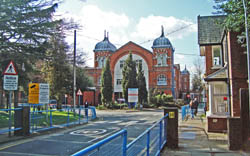
The main entrance from Whipps Cross Road with Ward Blocks C and D in view.
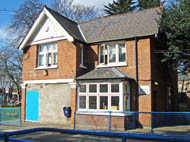
The Lodge by the entrance.

The northern elevation of Ward Blocks C and D on the western side.
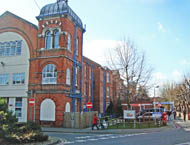
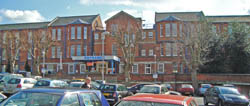
Ward Block D on the northwestern side of the Hospital (left). The side of the block shows the small administration block in the centre (right).

Ward Blocks A and B on the eastern side of the site (Ward Block A is the furthest away).

Each ward was connected to the other blocks by bridges constructed by brick arching. Some of the open walkways have been enclosed, as have the ward balconies.
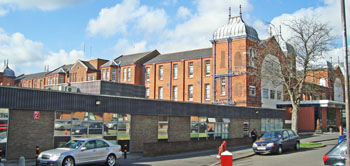
The Ward Blocks are impressively large.
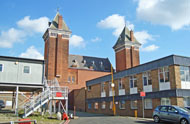
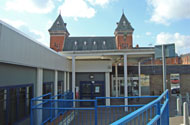
The towers of the administration building are never far from view (above and below). The original spaces between the buildings have been filled in with new wards and departments.
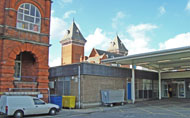

The Hospital enjoys a surfeit of architectural styles.

The eastern entrance to the Hospital from James Lane.

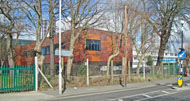
More modern buildings are located on the James Lane side of the site (above and below).

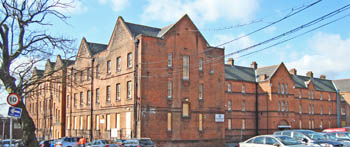
The Nurses' Home is now boarded-up.
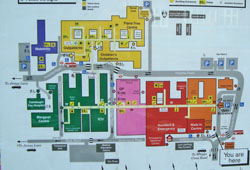
The site plan in 2009. More buildings have been added since.
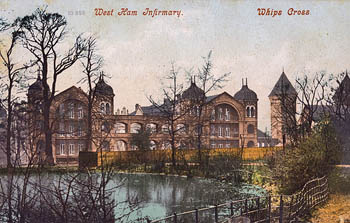
An undated postcard of the Infirmary showing a pond in the foreground. In 1949 the pond was filled in after a nurse drowned.
(Photograph reproduced by kind permission of
robmcrorie - flickr)
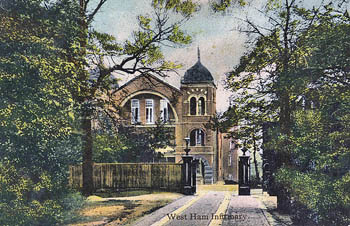
The entrance to the Infirmary off Whipps Cross Road in 1905. The view is similar to the modern day photograph (above), but the balconies have not yet been enclosed.
(Photograph reproduced by kind permission of
robmcrorie - flickr)
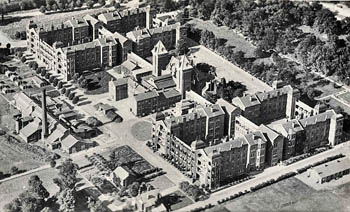
The Hospital site during the 1930s.
(Photograph reproduced by kind permission of
robmcrorie - flickr)
(Author unstated) 1917 List of the various hospitals treating military cases in the United Kingdom. London, H.M.S.O.
(Author unstated) 1917 Care of the wounded. British Journal of Nursing, 24th November, 340.
(Author unstated) 1949 Prize-giving day at Whipps Cross Hospital. British Journal of Nursing 97, 112.
http://en.wikipedia.org
http://hansard.millbanksystems.com
www.bbc.co.uk (1)
www.bbc.co.uk (2)
www.british-history.ac.uk (1)
www.british-history.ac.uk (2)
www.flickr.com (1)
www.flickr.com (2)
www.flickr.com (3)
www.flickr.com (4)
www.francisfrith.com
www.guardian-series.co.uk (1)
www.guardian-series.co.uk (2)
www.history-in-pictures.co.uk
www.leytonhistorysociety.org.uk
www.museumoflondonprints.com
www.scarletfinders.co.uk
www.topfoto.co.uk
www.whippsx.nhs.uk
www.workhouses.org.uk
www.wxhr.org.uk
www.yorkon.co.uk
Return to home page